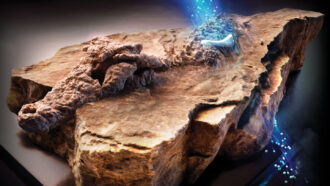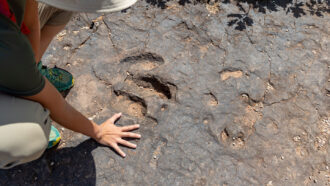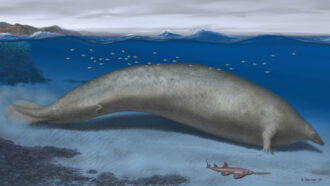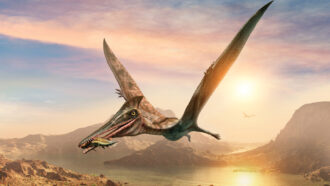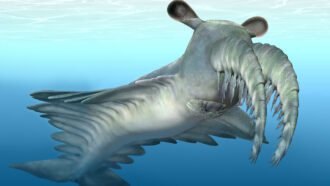Rhinos, camels and bone-crushing dogs once roamed Nebraska
An excavation site at an ancient watering hole reveals these secrets of the past and more
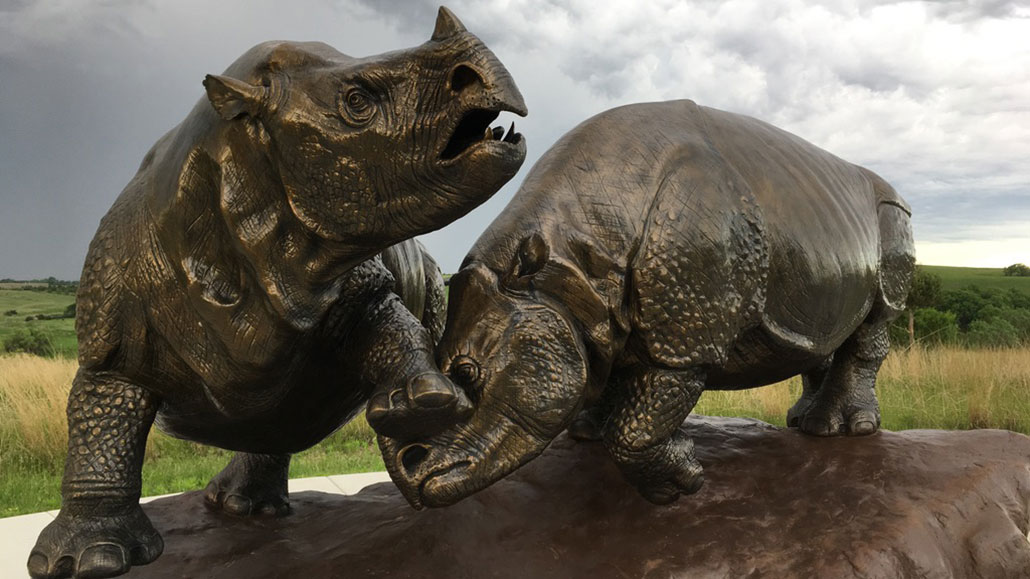
These full-sized rhino sculptures bring to life animals that lived millions of years ago in what is now Nebraska.
Sandy Mosel/Ashfall State Park
In north-central Nebraska lies a small park with a big name: Ashfall Fossil Beds State Historical Park and National Natural Landmark. Hidden in the rolling hills, hours from the nearest big city, Ashfall is one of the world’s premier paleontology sites. Park superintendent Rick Otto heads down a gently sloping path past two bronze sculptures. One shows two squatty rhinos locked in combat. A startled tortoise looks on from the other.
Signs mark geologic time as the path descends through layers of rock and into the ancient past. Otto pauses at one spot where the soil has been cleared out. It’s now a flat, gray area crisscrossed with shallow trenches. “When I first worked here, this was just a narrow gully,” he recalls. “A few days later is when the bulldozer was brought in for the first time.”
The area is now ringed with small red flags. They mark the first big excavation here, back in 1978. That was the year Mike Voorhies discovered what an extraordinary place this was.
A geologist at the University of Nebraska–Lincoln, Voorhies had already been exploring the area for several years. At one point in 1971, he spotted a jawbone jutting out from the side of the gully. What he dug out — an entire skull — had come from a baby rhino. It was the second rhino skull found in the hillside. Both had been trapped in a thick layer of volcanic ash. Voorhies suspected the ash-filled hillside hid much more.
And he was right. When he returned with a team years later, they uncovered a dozen rhinos and three horse skeletons.
Fossils of the plant-eating rhinos aren’t uncommon in Nebraska. Rhinos roamed the Great Plains of North America for more than 30 million years, until about 5 million years ago. Paleontologists, including Voorhies and Otto, have found rhino fossils all over the state. But those at Ashfall are remarkable. Each is a complete skeleton. Unbroken bones lay in place, oriented exactly as they had been in life.
And that’s what makes Ashfall so unusual. Ongoing excavation has revealed hundreds of skeletons. Layered atop the sandy bottom of an ancient watering hole, they reveal a world that resembled modern-day Africa. Here, predators prowled the area in search of an easy meal. And as new technology has emerged, old questions are finally starting to be answered.

Educators and Parents, Sign Up for The Cheat Sheet
Weekly updates to help you use Science News Explores in the learning environment
Thank you for signing up!
There was a problem signing you up.
Time capsule
Since his baby-rhino discovery 50 years ago, Voorhies, Otto and a small army of researchers have unearthed a mind-boggling number of fossils here. In 1978, they worked for four solid months. By the end, they had excavated 58 rhinos, 17 horses, six camels, five deer, two dogs, a rodent and dozens of birds and turtles. In all, researchers have unearthed more than 350 animals. The tens of thousands of individual bones and teeth come from animals that range from barrel-bodied rhinos to tiny songbirds, rodents, lizards and snakes.
What preserved so many animals and so well at this site? A supervolcanic eruption. Remains of an ancient volcano lie some 1,600 kilometers (1,000 miles) to the west. Active 12.5 million to 10 million years ago, its eruptions dumped ash across a large swath of North America. One eruption nearly 12 million years ago was especially massive. It left a layer of ash that stretched from its location in southwest Idaho all the way east to the Atlantic Ocean.
In that distant past, Nebraska was a grassy savanna. Trees and shrubs dotted the landscape. It likely resembled today’s Serengeti National Park in East Africa. Years of research show that this Ashfall site had been a watering hole. Rains filled it in the wet season. Afterward, many animals came here to drink. During the dry season, that water would evaporate.
The big volcanic eruption blanketed this part of Nebraska with a foot of ash. It’s easy to imagine the wind blowing it into drifts, like snow after a blizzard. Animals would have inhaled the ash. The tiny glass shards would have sliced up their lungs, making it hard to breathe. Grass-eating grazers would have nosed through it in search of food. They would have sought out the watering hole to drink. Maybe they waded in to escape the pale gray fluff. But it would have brought about their end anyway.
Over days, weeks and months, the animals here died in droves. Birds and turtles died quickly. We know this because their skeletons lie at the bottom of the ash, right on what was the sandy bottom of the watering hole. Other animals occur in layers. Above the birds and turtles lie dog-sized saber-tooth deer. Then five species of pony-sized horses, some with three toes. Above those are camel remains. Atop them all are the biggest, the rhinos, in a single layer. All of this is buried under about 2.5 meters (8 feet) of ash. It must have blown into the water, covering the dead.
Fossils in the ash bed are whole. They haven’t been squashed flat. Their bones are all still in place. They’re also fragile. Most fossils form when groundwater soaks into bones and teeth. Over time, minerals from the water fill in the gaps and even replace some of the original bone. The result is a hard, rock-like fossil that can stand the test of time.
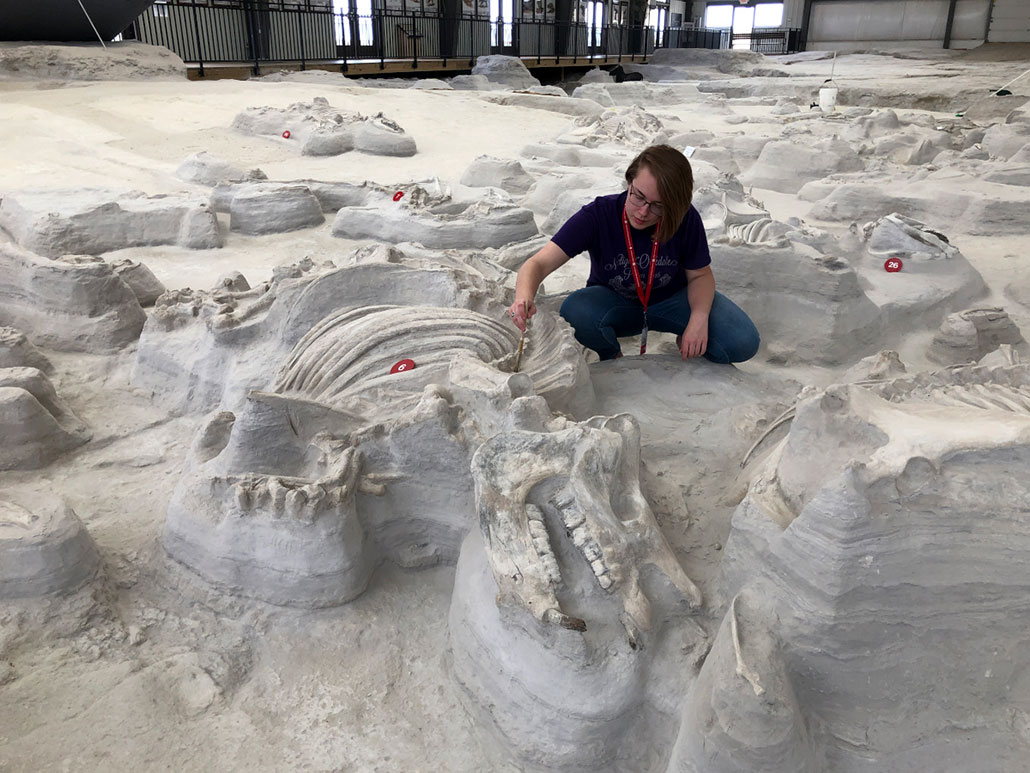
Here, however, the ash eventually locked the skeletons away from water. After the watering hole dried up, the super-fine ash left no room between particles for new water to seep in. The ash protected the bones, preserving them in their original positions. But they didn’t mineralize much. When scientist remove the ash around them, these bones start to crumble.
On the hunt for predators
One curious thing about Ashfall: Only two animals found in the ash bed were predators. Both were small dogs.
But there’s evidence much bigger predators lived in the area at the time of the ash storm. One sign: Some of the rhinos aren’t quite intact. Tooth-scraped ribs are strewn about in one area. Legs are pulled askew in another. Clearly, large predators came through, scavenging the dead. The small dogs couldn’t have done this.
For decades, no one knew what did. Then scientists learned to spot a new type of clue.
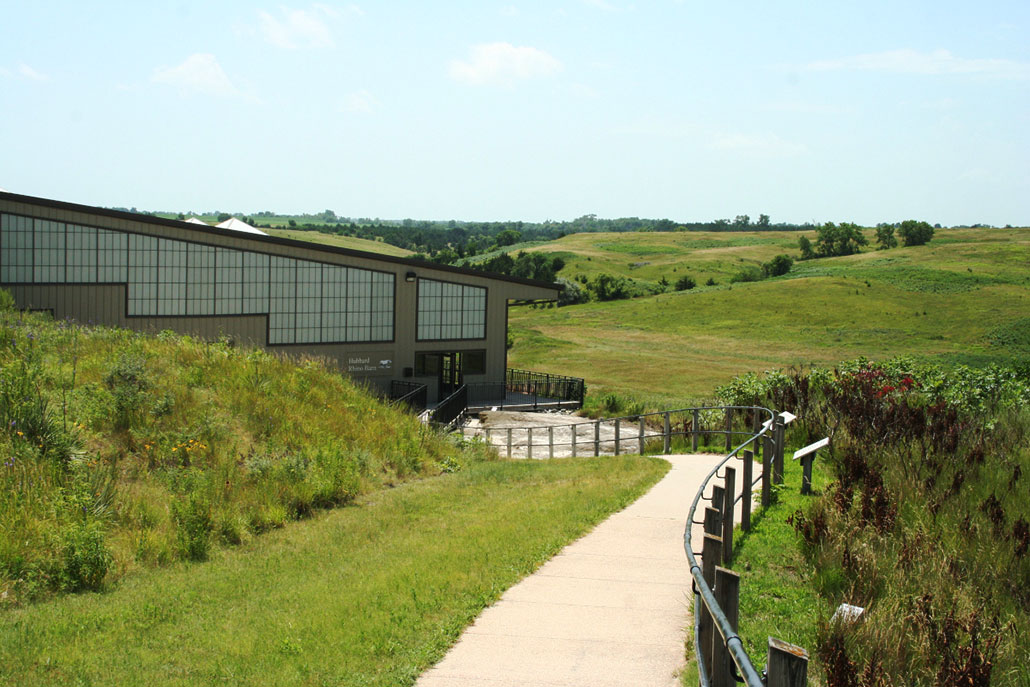
Otto heads into the Hubbard Rhino Barn. It sits on the hillside, next to the original dig site. The barn protects the current dig site from the elements. Inside, he follows a wooden walkway around the outer wall. Below, in the ash bed, two barefoot interns are clearing ash away with paintbrushes.
At the far end of the barn, Otto pauses. Here lie the older discoveries. Entire skeletons are jumbled together, held in place by pedestals of ash. He pulls a laser pen from his shirt pocket and shines the green light on a column of ash next to a rhino with scattered ribs.
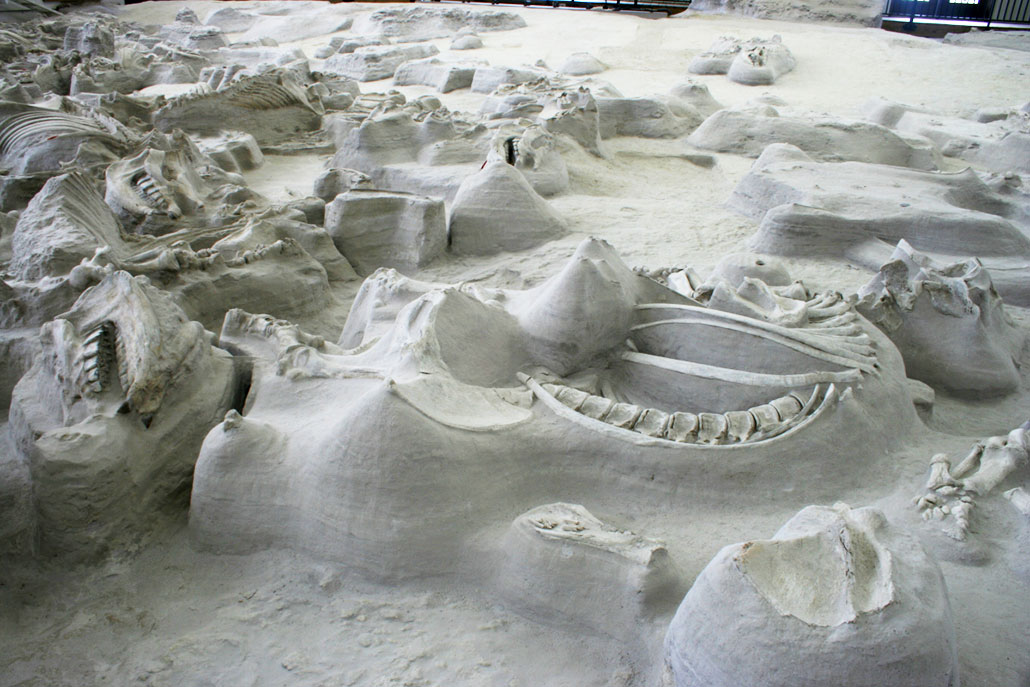
“Notice this swirl right here,” he says. “That must be a track. No doubt that’s where a scavenger, bone-crushing dog stepped when it was lifting the ribs off of the rib cage.” These dogs were many times bigger than the small ones found in the ash. The swirl is the cross-section of a track that one of these dogs left behind as it walked on a layer of algae, Otto explains. After decades of work, someone realized thin white bands in the ash column weren’t simply different colored ash. They are fossilized algal mats. And they hold ghostly evidence of the area’s biggest predators.
Out on the ash bed, interns Eli Kliment and Sophia Beery are hard at work. They’re college students — and future paleontologists — working here for the summer. Digging in the ash, they’re getting essential field experience. But they’re unlikely to discover new skeletons this season. They’re too busy scouting for dog tracks.
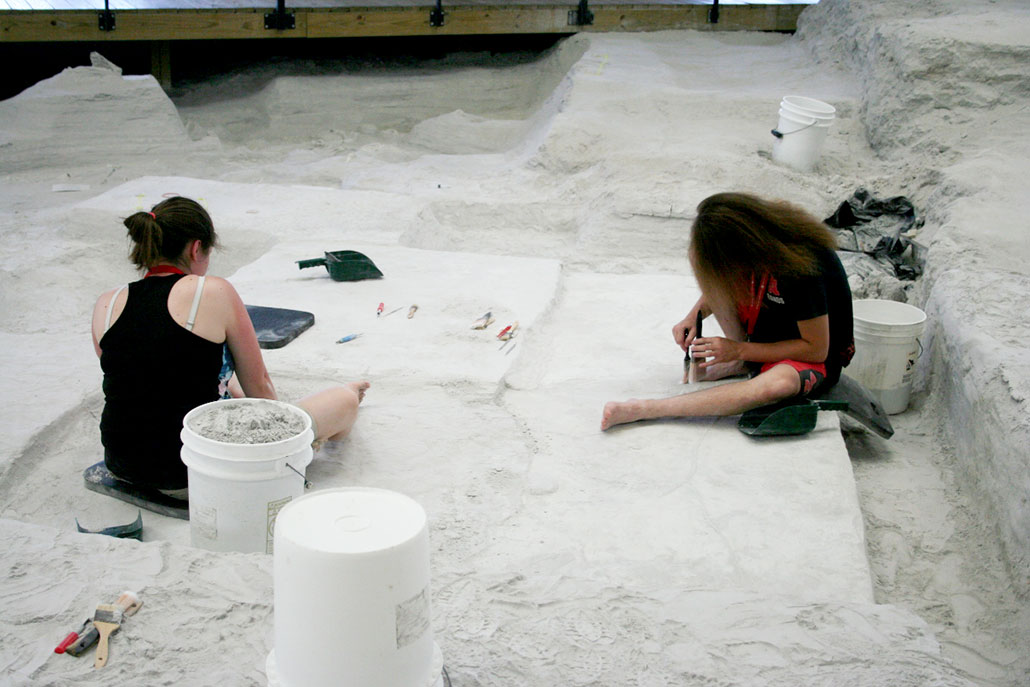
“Once we hit an algae layer, we uncover it from one end to the other,” Beery explains. “Usually we find wrinkles,” she says. These are places where the algae folded as it settled. But “where the footprints are, it flattens,” she explains. The dog’s weight pressed the algae flat. It’s a sign the interns hope to see, although flat algal mats don’t always yield tracks. Beery points to an algal mat with three red plastic circles on it. Inside the circles are ghostly paw prints — big ones.
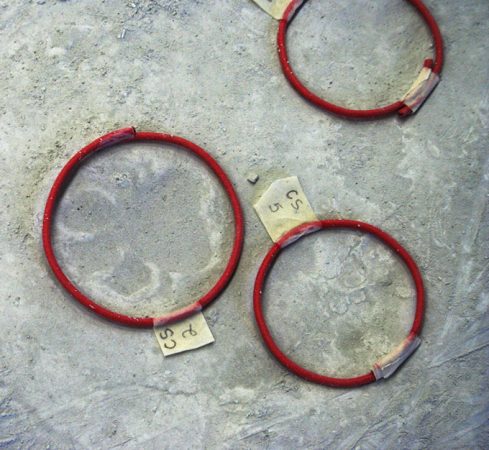
It’s a slow process. When interns find an algal layer, they gently brush the ash off the entire mat. Then Otto inspects it for more of those ghost tracks. Where he finds them, plastic circles are added to mark them. Then the intern starts working in a new spot. If there aren’t tracks, the interns take pictures of the layer before digging deeper.
Footprints “can tell us at what time frame the dogs were coming through,” Beery explains. She points to two different sets of prints. One set is about 15 centimeters (6 inches) higher than the other. “There were multiple times when scavengers were coming through and feeding on the bodies.” The lower prints came first, when animals were still dying in the water. Those on the upper layer of algae came days or weeks later.
Searching for new clues
Inside the barn, ash is still being studied. There’s a large area where little has been done beyond a digging of exploratory trenches. The question: Where is the best place to search for the next big discovery?
Michelle Proulx is trying to figure that out. She’s a graduate student at the University of Kansas in Lawrence. There, Proulx works with geophysicist George Tsoflias. They surveyed Ashfall with ground-penetrating radar, or GPR. These beams of radio waves bounce off underground features at different rates, depending on their makeup and structure. An antenna detects waves that return to the surface. The result is an image of underground structures and, possibly, objects. It’s similar to how a bat uses sonar to “see” its surroundings.
Proulx and Tsoflias beamed GPR into areas of the ash bed that had not yet been excavated. They used two different radio frequencies: 500 megahertz and 1,000 megahertz. Frequency denotes the number of times a wave peaks in one second. The lower the frequency, the longer the wavelength. As a lower frequency, the 500 megahertz wave travels more deeply into the ground. The higher-frequency 1,000 megahertz waves don’t travel as deeply. They can, however, provide pictures of shallow layers in better detail.
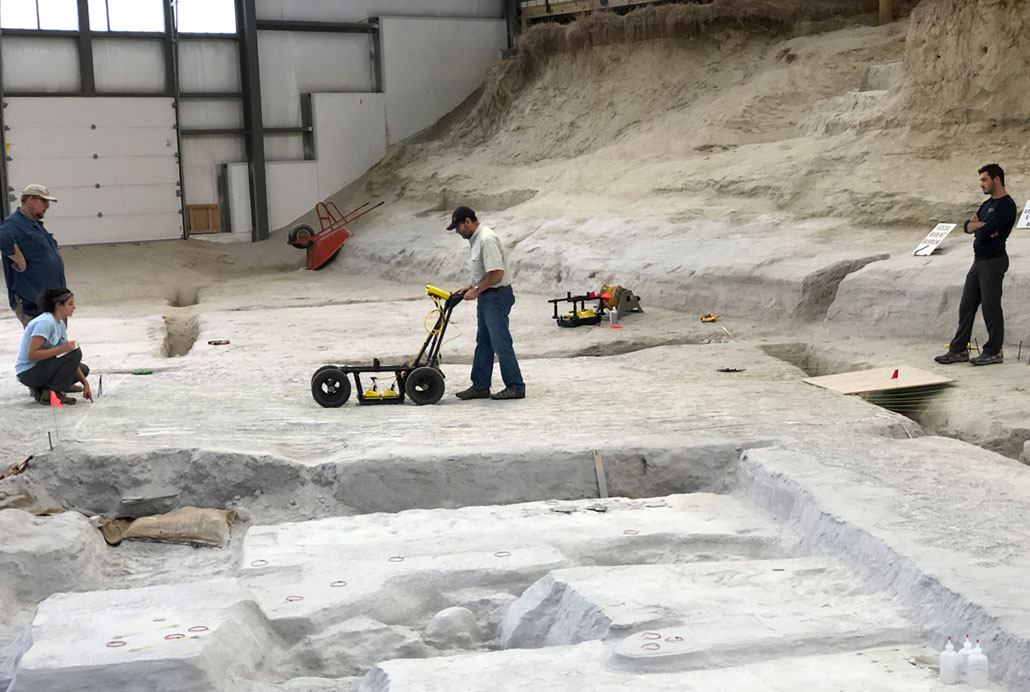
GPR has been used successfully to locate bones buried in sandstone and soil at other sites. But “no one had really done any surveys with GPR looking at skeletal remains in very, very fine volcanic ash like we see at Ashfall,” Proulx says. So she decided to try both frequencies. She hoped that one of them would help locate buried skeletons.
When she and Tsoflias looked at the data that came back, they found a remarkably clear image of the ash. The lower frequency GPR created a clean picture of where the ash ended and the sandy layer began. But it turned up no bones. The high-frequency GPR, however, picked up disturbances in the ash. “That’s actually the clearest we’ve ever seen in a GPR survey,” Proulx says. But did it mean there were bones in the ash?
To find out, Otto’s interns excavated one site with two of those GPR disturbances. One turned out to be a rhino skull. The other was the rhino’s rib cage. “I’m sure if we went to a higher frequency, we could see more detail,” Proulx says. But that’s a study for a future date. Ashfall Park just reopened to visitors for the season. New interns will be arriving soon to search for more clues to Nebraska’s ancient past.
Alison Pearce Stevens has been a regular contributor to Science News for Students since 2012. This piece — her 119th for us — was inspired by her new book: Rhinos in Nebraska: The amazing discovery of the Ashfall Fossil Beds (Henry Holt & Co., New York, July 2021, 144 pp).


